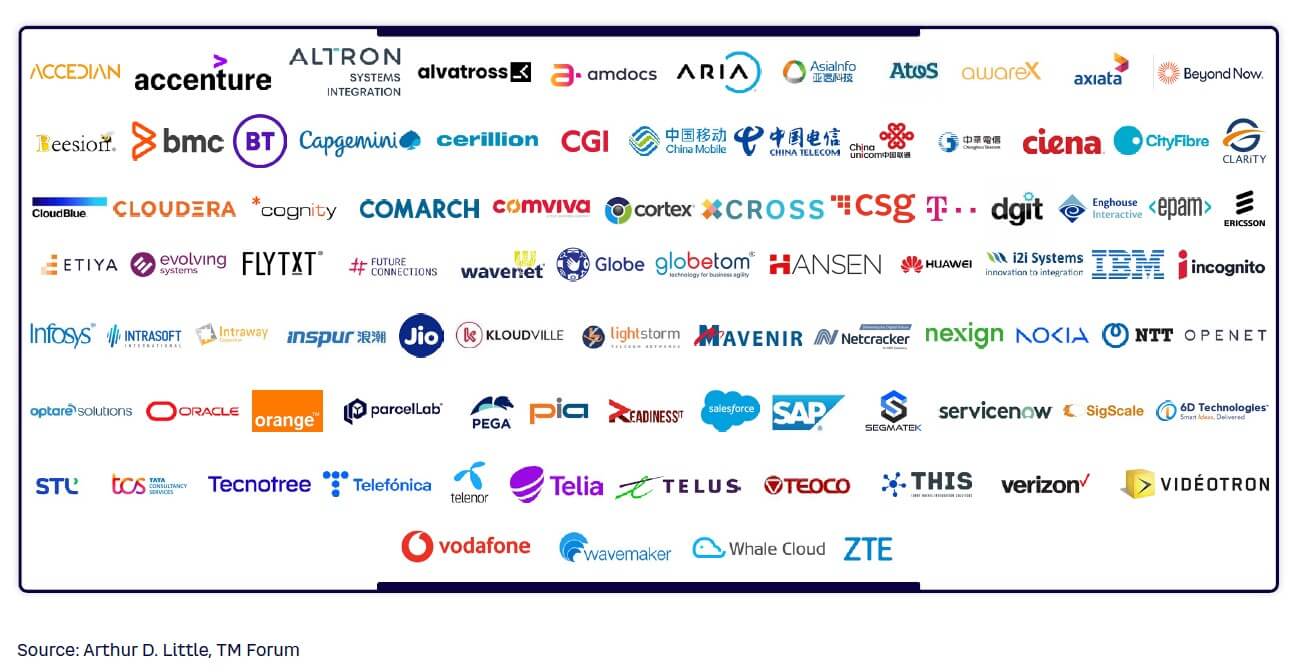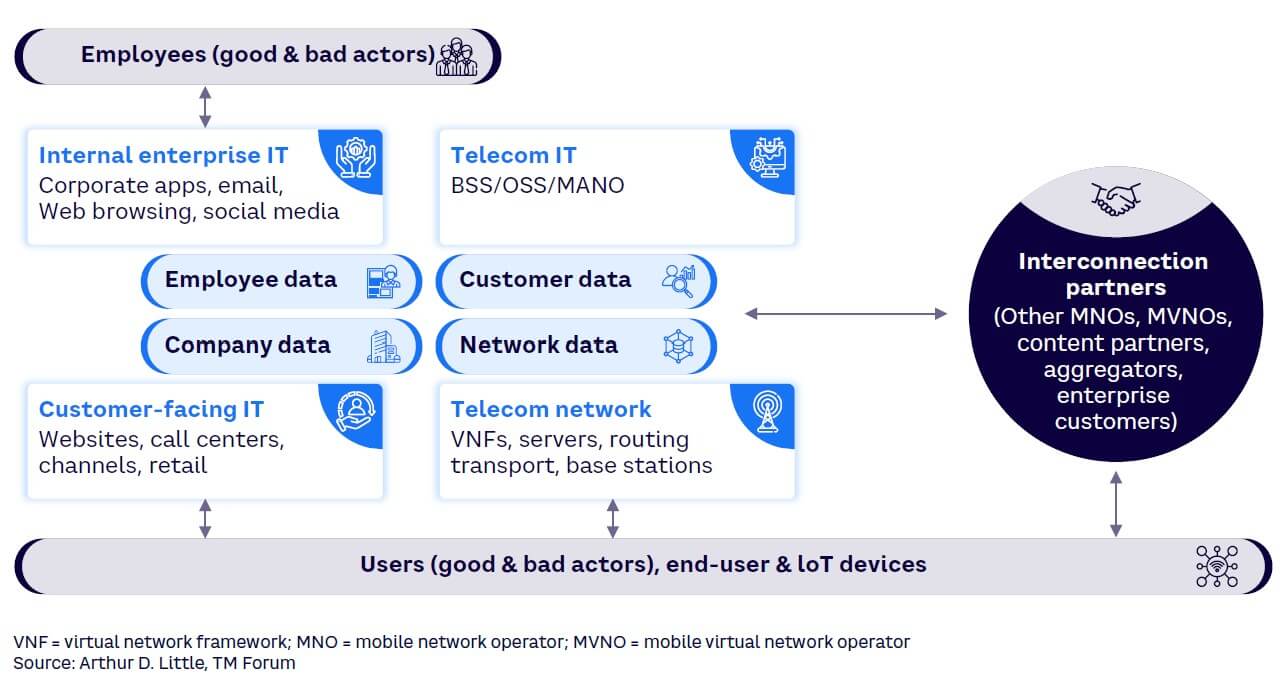
DOWNLOAD
DATE
Contact
Open digital architecture (ODA) is transforming the telecom industry. By standardizing software components and enabling API-driven business models, ODA promises faster development of innovative new services at reduced cost. However, to fully realize ODA’s potential, communication service providers (CSPs) must navigate challenges like security risks, evolving policies, and cultural shifts. Embracing customer-centricity, operational excellence, and strategic partnerships are key to thriving in this changing landscape.
ODA is a trend CSPs cannot ignore. As the precondition to truly API-enabled networks, we anticipate ODA becoming a key enabler for growth and innovation in the telecom industry. ODA comprises an architecture framework, common language, and design principles and defines standardized, interoperable software components organized into loosely coupled domains. These components expose business services through open APIs built on a common model. The APIs unlocked by ODA promise multiple cost efficiencies and new business models for CSPs, allowing operators to respond with agility in the face of changing consumer needs and zero in on specific customer segments with bespoke propositions. ODA’s modular nature and the streamlined deployment of propositions it enables will be a key source of competitive advantage in the coming years.
WHAT IS ODA?
Bespoke software architecture made sense for the integrated telecom business, as competitive advantage could be built across each operating layer. However, this model is no longer fit for purpose. Disintermediated by players specializing in particular layers, CSPs risk losing their edge in those layers beyond the simple transmission of data. CSPs need open, interoperable architecture that allows them to react nimbly to evolving customer and market needs.
This disaggregation of CSPs’ technology stack is part of a broader trend. CSPs have historically been asset-centric organizations that deliver and monetize traditional connectivity, with a focus on efficiency and return on invested capital. Delivery of these services was best done using custom code and operational siloes. The new use cases that came with 4G, 5G, and smartphones have allowed other players to enter the CSP value chain, including over-the-top (OTT) players within value-added services and iOS within the operating layer. ODA will help CSPs transition into solution-centric companies disaggregated from their physical and network infrastructure, giving them greater freedom to decide where to play.
The ODA framework, designed by TM Forum and adopted by a growing number of telecom operators, provides a blueprint for this, with enterprise architecture that can be implemented across the industry.[1] Often deployed on cloud-based infrastructure for its flexibility and scalability, ODA can be adapted to environments such as cloud, hybrid, and on-premises. By standardizing back-end (BSS) and front-end (OSS) software architectures, ODA enables a plug-and-play approach to applications, fostering interoperability and fueling the ongoing API revolution in the telecom sector. The framework covers five key areas: (1) governance, (2) business, (3) information systems, (4) implementation, and (5) deployment/runtime, and its implementation means a dramatic transformation for CSPs as they seek future growth.
THE IMPACT OF ODA ON TELECOM OPERATORS
ODA is expected to become a key driver of innovation and growth for telecom operators. Although no major CSPs have fully implemented all ODA principles, leading operators have committed to its principles and are planning implementation (see Figure 1). Vodafone has been a leading supporter of this change:
“Vodafone has been at the forefront of utilizing TM Forum’s open digital architecture and open APIs to enhance the customer experience across multiple channels and unlock new revenue streams.”
Scott Petty, Vodafone Group CTO

With formal ODA certification launching in January 2025, ODA, as the key enabler for API-driven business models, will allow CSPs to determine which products and services to keep in-house and which to outsource. This change will require a mindset shift from CSPs, as future capabilities and product offerings will require deep partnerships with players and providers to fully realize the API transformation. The benefits described below are at the core of the shift to ODA.
Faster, less expensive development & scaling
In the past, software was created for a CSP’s specific architecture. The difficulty and cost of developing such software, and the second- and third-order dependencies they constructed with other value chain layers, caused resistance to changing and updating systems. As systems became increasingly complex, this problem compounded.
ODA solves this. With its common architecture, language, and design principles, the switching costs associated with introducing a new system to the CSP tech stack (e.g., sales CRM, interoperability) are significantly reduced. Interoperable components are both plug-and-play and highly automatable. This allows CSPs to treat their tech stack as modular, rather than a monolith. CSPs can flexibly swap in and out software microservices at greater speed and better react to changing customer and market dynamics.
Once developed, ODA’s cloud platform allows for faster, less expensive deployment and scaling. In the past, new propositions had to negotiate the finite dimensions of in-house compute and storage capacity, with some limited outsourcing of data centers, based on the cloud. With ODA, propositions can be easily deployed and scaled up, helping CSPs become much more responsive to demand, a key advantage. Vodafone’s ODA adoption provides strong evidence for this, with the technology allowing the firm to speed up product launches, which boosted digital sales by more than 50% and sales conversions by 30%, with its customer experience (CX) platform becoming a model for Vodafone worldwide.
Finally, the cloud-based approach allows CSPs to unlock the benefits of ODA without the need to deploy CAPEX in building data centers and compute capacity, an important benefit given CSPs’ high debt/equity ratios.
Business model innovation
Improved development times help CSPs innovate their business models. Constraints from inflexible tech stacks and the costly nature of innovating on them led to cookie-cutter business models with standardized pricing and plans designed to serve broad customer groups.
ODA also facilitates further customer segmentation. With a flexible tech stack and relatively fast implementation times, CSPs can afford to produce bespoke products and packages for customer segments. This lets them offer more competitive products and capture more value from customers. Axiata (Jio) is a prime example: its ODA adoption allows the firm to develop go-to-market strategies in days rather than months while reducing IT costs by 40%. Although not widely discussed, the flexible nature of the ODA tech stack will allow CSPs to experiment with new technologies and may allow for the creation of entirely new business models.
Cost efficiencies
ODA is projected to be a major driver of cost savings for CSPs. Under the “old” model of proprietary tech stacks, high switching costs drove high vendor software pricing. Moreover, innovating on or introducing new elements to these tech stacks is time-consuming and costly. ODA solves this problem. First, products developed under ODA are interoperable and highly interchangeable, owing to the modular nature of the overall stack. This reduces the possibility of vendor lock-in, as incumbent software providers can no longer rely on difficulty of replacement as a competitive “moat.” Instead, they must compete on price and performance.
Second, the plug-and-play nature of ODA will greatly reduce the cost of innovating on and adding to the CSP tech stack. With high levels of automation, shorter time to value, and easier acquired talent (owing to the use of universal design principles), the cost of implementing changes will decrease.
We should note that significant investment is required to achieve the long-term cost efficiencies of ODA, as CSPs’ tech stacks must be overhauled. However, the efficiencies and additional revenues from ODA implementation will far outweigh these costs.
CHALLENGES & RISKS
ODA represents a fundamental shift for the telecom industry, in both infrastructure and company culture. Figure 2 shows where the risks and challenges lie.

Data & security
First, in moving their networks to the ODA standard, CSPs will inevitably create a larger attack surface, making security more challenging. Few CSPs have a single network design and source of truth. ODA breaks down the data and network siloes within a CSP, and this makes the data and network infrastructure more vulnerable to a serious breach. This must be a key consideration of CSPs during their ODA transformation.
Second, ODA introduces automation and AI as a standard element of the network. Although a key enabler to many of ODA’s benefits, this presents risks around privacy and regulatory compliance and is particularly important for CSPs that consider security a key differentiator.
“Security and privacy are the secret weapons we have in building trust. We haven’t really monetized it yet.”
Ruza Sabanovic, Executive VP, Telenor Group
Third, the integration of third-party APIs and other software may introduce vulnerabilities into the CSP’s network, threatening its security and integrity. This risk must be carefully managed by operators as they transition to ODA.
Evolution of ODA standards
The telecom industry is constantly evolving; so, too, will ODA’s policies and components. By tying their code infrastructure to a particular set of ODA guidelines, whether TM Forum’s or not, CSPs will give up control of their architecture to some extent. Proprietary code as a source of competitive advantage will be a thing of the past.
Given the evolutionary nature of ODA policies, CSPs will need ongoing development efforts to remain in compliance. Otherwise, they risk dysfunctional APIs that no longer work with their platform. Ongoing development efforts will be costly, potentially prohibitively so for smaller players. Some CSPs may find that the costly tweaks and changes to the underlying code base conflict with their strategic direction or are simply irrelevant to the organization. Regardless, CSPs will be tied to implementing the changes agreed on by their ODA alliance.
Cultural change & skills gap
As the technology landscape changes, each CSP must ensure its workforce is equipped with the necessary skills to manage and maintain the ODA environment. With its cloud platform, modular nature, and reliance on Kubernetes, many firms will see a skills gap emerge. A successful ODA transition requires substantial investments in training, development, and recruitment.
ODA implementation also requires an agile culture that embraces innovation and speed. ODA may require significant changes to the organization’s structure, processes, and culture, and resistance to those changes from employees and/or management may hinder the implementation process.
Migration risks
Integrating legacy systems with new architecture can be fraught with compatibility issues and data migration hurdles that can lead to unforeseen costs and delays. Moreover, the sheer volume of sensitive customer and operational data involved in an ODA transition demands meticulous planning and robust security measures to prevent loss, corruption, or unauthorized access during migration.
Shifting to ODA requires proficiency in cloud-native technologies and API management, potentially creating a skills gap that necessitates investment in training or recruitment. Culturally, the transition to a more agile and collaborative model can pose challenges. Although ODA champions open standards, the risk of vendor lock-in remains a concern, necessitating careful vendor selection and ensuring seamless integration between various components. The financial and temporal implications of ODA migration are significant, and underestimating the complexity or encountering unforeseen technical issues can result in cost overruns and project delays.
Finally, the telecom industry’s stringent regulatory environment demands rigorous compliance, ensuring the new architecture adheres to data protection, privacy, and security standards. To navigate these complexities, a phased approach with pilot projects, comprehensive planning, and robust risk assessment and change management strategies is crucial.
THE FUTURE OF ODA
The future of ODA in the telecom industry will be shaped by several factors, including technological advancements, industry collaboration, evolving customer expectations, competitive market dynamics, and regulatory developments.
We expect the value that ODA brings to CSPs to grow in the coming years. The integration of 5G and edge computing, the application of AI and machine learning, and the expansion of Internet of Things (IoT) and smart city initiatives drive ODA adoption. These technologies help operators offer faster, more reliable, and innovative services to their customers, and they increase the value available to be captured by ODA adoption.
Industry collaboration and standardization are also on the rise. Since its launch in 2018, TM Forum’s ODA has seen a steady rise in signatories, including traditional CSPs like Telenor and Deutsche Telecom; vendors such as Nokia, Salesforce, and Oracle; and hyperscalers such as Google.
We believe ODA will become an industry standard in the coming years, and that collaboration will be deepened by the need to integrate a growing number of APIs within the CSP tech stack. As collaboration (and with it the number of APIs) increases, interoperability issues may arise that require robust governance frameworks to manage effectively. This could lead to ODA becoming slower to change, as more signatories mean less agility.
CSPs will likely become increasingly customer-centric. ODA lets telecom operators be more agile and customer-centric in their service offerings, and this ability will become an important competitive edge. Conversely, over-customization may lead to increased complexity and potential operational inefficiencies.
There’s little doubt that ODA will change the competitive landscape. Expect new market entrants and disruptive business models, as well as consolidation/convergence of services across industries. This will drive an increased focus on differentiation and value-added services. The GSMA’s CAMARA project leads this trend, aiming to enhance customer and developer ecosystems via an open, global, accessible API solution. By offering opportunities for collaboration between network and cloud companies to address porting and reproduce API services across operator architecture, steps are already being taken to change the competitive landscape.
The future of ODA in the telecom industry presents both opportunities and challenges for operators. To succeed, they must adapt and evolve with ODA trends; seize opportunities for cost reduction, operational efficiency, and innovation; and address potential barriers to adoption and growth.
WHAT MUST OPERATORS DO TO SUCCEED?
As the market transitions to ODA, CSPs should adapt and evolve by focusing on four strategies.
1. Customer-centric technology adoption & innovation
CSPs can embrace innovation by staying informed about emerging technologies, trends, and best practices in the ODA ecosystem. Being open to adopting new technologies will allow CSPs to achieve the gains in agility, efficiency, and CX that ODA offers. Customer centricity should drive CSPs’ innovation and technology adoption by conducting small-scale pilots of ODA-enabled services tailored to specific customer segments and then using feedback to refine services before scaling, gaining both experience in ODA build but also better market fit. By prioritizing customer needs and expectations in the design and delivery of ODA-based services and continuously gathering and using customer feedback, CSPs can make more informed decisions and drive improvements, ensuring they remain competitive and relevant. Leveraging data and analytics will be crucial — insights into customer behavior, market trends, and operational performance should strongly influence decision-making.
2. Operational excellence
Operational excellence requires CSPs to continuously review and optimize processes, systems, and infrastructure to ensure maximum efficiency, scalability, and performance within the ODA landscape. In part, this means understanding that adopting agile methodologies and practices enables faster decision-making, more efficient operations, and quicker responses to market changes and customer demands. CSPs must also establish KPIs to monitor the success of ODA initiatives and use this data to drive continuous improvement and demonstrate the value of ODA to stakeholders. Proactive risk management is essential to identifying and addressing potential risks and challenges associated with the ODA transition, including security threats, compliance requirements, and operational complexities.
3. Workforce & culture development
Investing in workforce development is critical to a successful ODA transition. CSPs must equip employees with the necessary skills and knowledge to thrive in the ODA environment through training, development, and recruitment efforts. A successful transition to ODA requires new skills and approaches, so encouraging a culture of continuous learning and adaptability will be critical. Fostering a culture of collaboration is also vital. Cross-functional collaboration within CSPs helps break down silos and ensures a unified approach to ODA implementation and ongoing operations. This is particularly important for CSPs that have grown through M&As and thus have a diverse workforce.
4. Strategic partnerships
Developing strategic partnerships with vendors and partners is critical in the API-based CSP environment. Few CSPs will successfully fight and win within each layer of the CSP value chain. Instead, they must identify those capabilities and functions too far from the CSP’s core operations, or where margins are too thin, and form high-quality partnerships. Once formed, these relationships will allow CSPs to access new technologies, skills, and methodologies that can enhance overall performance.
Conclusion
5 KEY STEPS
By focusing on a proactive, strategic approach to the ODA transition, CSPs can position themselves for success in the rapidly evolving telecom landscape. To successfully navigate the shift to ODA, CSPs must:
- Embrace innovation. Actively adopt ODA-related technologies to stay competitive and enhance CX.
- Prioritize customer-centricity. Tailor services and offerings based on deep customer insights and data analytics.
- Drive operational excellence. Continuously optimize processes and infrastructure, using agile methodologies to respond quickly to market changes.
- Invest in workforce development. Equip the team with the necessary skills and foster a culture of continuous learning and collaboration.
- Form strategic partnerships. Collaborate with vendors and partners to access cutting-edge technologies and capabilities beyond your core operations.
Together, these actions will position CSPs to thrive in the evolving ODA landscape.
Note
[1] Additional information on ODA can be found at TM Forum.





